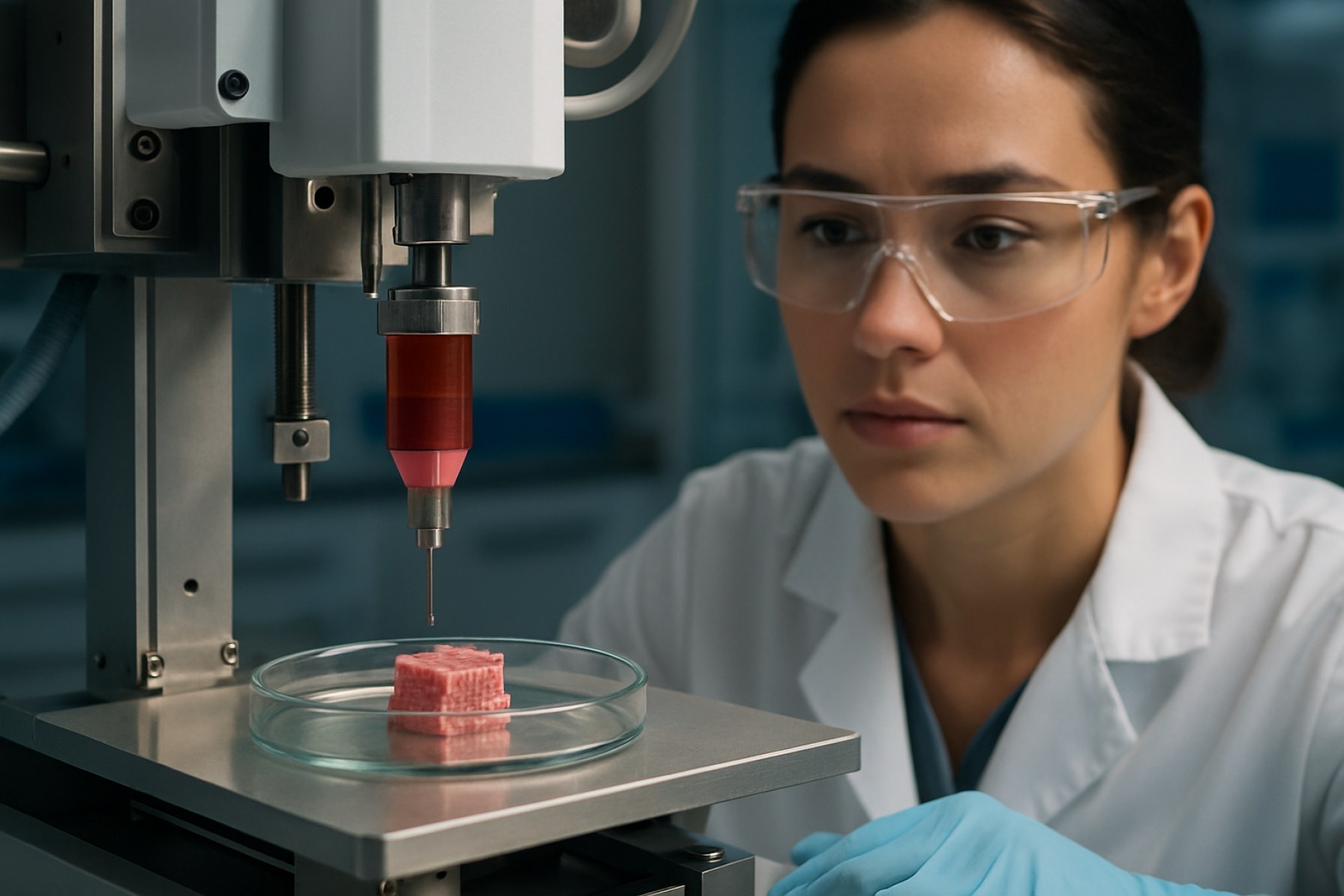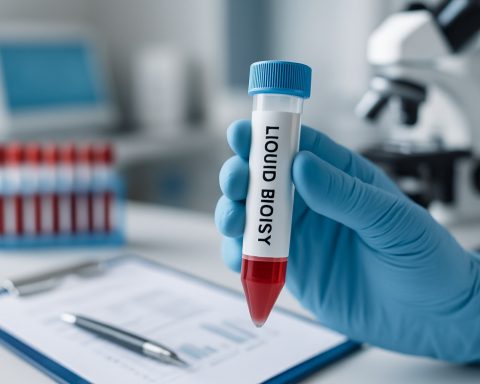Bioprinting Unveiled: How 3D Printing is Revolutionizing Medicine, Research, and Beyond. Explore the Science, Innovations, and Real-World Impact of Fabricating Living Structures. (2025)
- Introduction to Bioprinting: Principles and Evolution
- Key Technologies: From Bioinks to 3D Bioprinters
- Major Players and Pioneering Institutions in Bioprinting
- Applications in Regenerative Medicine and Organ Fabrication
- Bioprinting in Drug Discovery and Personalized Medicine
- Ethical, Regulatory, and Safety Considerations
- Market Growth and Public Interest: Trends and Forecasts
- Challenges and Limitations Facing Bioprinting Today
- Case Studies: Success Stories and Clinical Trials
- Future Outlook: Next-Generation Bioprinting and Societal Impact
- Sources & References
Introduction to Bioprinting: Principles and Evolution
Bioprinting, a specialized branch of additive manufacturing, involves the precise layer-by-layer deposition of living cells, biomaterials, and growth factors to fabricate tissue-like structures. The core principle of bioprinting is to mimic the complex architecture of native biological tissues, enabling the creation of functional constructs for research, drug testing, and, ultimately, therapeutic transplantation. The process typically employs computer-aided design (CAD) to guide the spatial arrangement of bioinks—mixtures of cells and supportive matrices—using various printing modalities such as inkjet, extrusion, and laser-assisted techniques.
The evolution of bioprinting has been marked by significant milestones over the past two decades. Early experiments in the 2000s demonstrated the feasibility of printing simple cell patterns, but it was not until the 2010s that advances in stem cell biology, biomaterials, and printing hardware enabled the fabrication of more complex, multicellular structures. By the early 2020s, research groups and companies had successfully printed skin, cartilage, and vascularized tissue models, with some constructs entering preclinical testing. Notably, organizations such as Wake Forest Institute for Regenerative Medicine and 3D Systems have played pivotal roles in advancing both the science and technology of bioprinting.
As of 2025, bioprinting is transitioning from proof-of-concept demonstrations to more robust, reproducible applications. The field is witnessing the emergence of standardized bioinks and printing protocols, which are essential for regulatory approval and clinical translation. For example, Organovo, a pioneer in commercial bioprinting, continues to develop 3D-printed human tissue models for pharmaceutical testing, while academic consortia are exploring the bioprinting of organoids and microtissues for disease modeling. The integration of artificial intelligence and real-time imaging is further enhancing the precision and scalability of bioprinting platforms.
Looking ahead to the next few years, the outlook for bioprinting is characterized by cautious optimism. While the fabrication of fully functional, transplantable organs remains a long-term goal, incremental advances are expected in the production of vascularized tissues, personalized grafts, and high-throughput tissue models for drug discovery. Regulatory agencies, including the U.S. Food and Drug Administration (FDA), are actively engaging with stakeholders to establish guidelines for the clinical use of bioprinted products. As interdisciplinary collaboration intensifies, bioprinting is poised to become an integral component of regenerative medicine, with the potential to address critical shortages in donor tissues and revolutionize personalized healthcare.
Key Technologies: From Bioinks to 3D Bioprinters
Bioprinting, the layer-by-layer fabrication of living tissues using 3D printing technologies, is rapidly advancing as a cornerstone of regenerative medicine and tissue engineering. As of 2025, the field is defined by innovations in both bioinks—the cell-laden materials used for printing—and the bioprinters themselves, which are becoming increasingly sophisticated and accessible.
Bioinks are central to the success of bioprinting. Recent years have seen a surge in the development of bioinks that better mimic the extracellular matrix, support cell viability, and enable complex tissue architectures. Hydrogels derived from natural polymers such as alginate, gelatin, and collagen remain popular, but there is growing interest in synthetic and hybrid materials that offer tunable mechanical and biological properties. For example, researchers at National Institutes of Health and Harvard University have reported advances in bioinks that allow for vascularization—an essential step toward printing functional, large-scale tissues. In 2024, several groups demonstrated bioinks capable of supporting the growth of multiple cell types, a key requirement for organ-level complexity.
On the hardware side, 3D bioprinters are evolving to accommodate a wider range of bioinks and to achieve higher resolution and throughput. Leading manufacturers such as CELLINK (a BICO company) and Organovo are introducing multi-material printheads, temperature-controlled platforms, and integrated imaging systems for real-time quality control. These features are enabling the fabrication of tissues with intricate microarchitectures and multiple cell types, moving closer to the goal of printing functional organs. In 2025, desktop bioprinters are becoming more common in academic and hospital settings, democratizing access to the technology and accelerating research.
Automation and artificial intelligence are also being integrated into bioprinting workflows. AI-driven design tools are optimizing print parameters and predicting tissue maturation outcomes, while robotic systems are streamlining the handling of delicate cell-laden constructs. The U.S. Food and Drug Administration is actively engaging with the bioprinting community to develop regulatory frameworks for clinical translation, with several tissue models already in preclinical and early clinical evaluation.
Looking ahead, the next few years are expected to bring further convergence of materials science, robotics, and biotechnology. The focus will likely shift toward printing more complex, vascularized tissues, scaling up production for clinical trials, and refining quality assurance protocols. As these technologies mature, bioprinting is poised to transform personalized medicine, drug testing, and ultimately, organ transplantation.
Major Players and Pioneering Institutions in Bioprinting
As bioprinting advances toward clinical and industrial maturity in 2025, a select group of companies, research institutions, and public organizations are shaping the field’s trajectory. These major players are driving innovation in bioink development, printer hardware, and the translation of bioprinted tissues toward therapeutic and research applications.
- Organovo Holdings, Inc. remains a prominent name in the bioprinting sector, recognized for its early commercialization of 3D bioprinted human tissues for drug discovery and disease modeling. The company’s proprietary platform enables the fabrication of functional human tissue constructs, with ongoing efforts to expand into therapeutic tissue development. Organovo’s collaborations with pharmaceutical companies and research institutions continue to accelerate the adoption of bioprinted models in preclinical testing (Organovo Holdings, Inc.).
- Cellink, a subsidiary of BICO Group, is a global leader in bioprinter manufacturing and bioink formulation. Cellink’s modular bioprinters are widely used in academic and industrial laboratories, supporting applications from tissue engineering to cancer research. The company’s open-source approach and partnerships with leading universities have fostered a robust ecosystem for bioprinting innovation (Cellink).
- Aspect Biosystems, based in Canada, is pioneering microfluidic 3D bioprinting technology. The company’s platform enables the creation of highly structured, functional tissues, with a focus on therapeutic applications such as pancreatic tissue for diabetes and liver tissue for metabolic diseases. Aspect Biosystems’ collaborations with pharmaceutical and biotechnology firms are expected to yield preclinical and early clinical data in the coming years (Aspect Biosystems).
- United States National Institutes of Health (NIH) plays a central role in funding and coordinating bioprinting research across the U.S. The NIH supports multi-institutional initiatives, such as the Tissue Chip for Drug Screening program, which leverages bioprinting to create organ-on-chip models for drug toxicity and efficacy testing (United States National Institutes of Health).
- Fraunhofer Society in Germany is a leading applied research organization with dedicated programs in bioprinting for regenerative medicine and personalized implants. The Fraunhofer Institute for Interfacial Engineering and Biotechnology (IGB) is particularly active in developing printable biomaterials and scalable tissue manufacturing processes (Fraunhofer Society).
Looking ahead, these organizations are expected to deepen their collaborations, expand clinical translation efforts, and address regulatory challenges. The next few years will likely see the first clinical trials of bioprinted tissues, broader adoption in pharmaceutical R&D, and the emergence of new players as the technology matures.
Applications in Regenerative Medicine and Organ Fabrication
Bioprinting, the layer-by-layer fabrication of living tissues using bioinks composed of cells and biomaterials, is rapidly advancing regenerative medicine and organ fabrication. As of 2025, the field is transitioning from proof-of-concept studies to early-stage clinical and preclinical applications, with a focus on addressing the shortage of transplantable organs and developing functional tissue models for research and therapy.
One of the most significant milestones in recent years has been the successful bioprinting of complex tissue constructs with vascular networks, a critical step toward fabricating viable, large-scale organs. Research groups and companies are now able to print tissues such as skin, cartilage, bone, and even miniature liver and kidney models that demonstrate essential physiological functions. For example, Wake Forest Institute for Regenerative Medicine, a global leader in the field, has reported progress in printing vascularized tissue patches for potential use in organ repair and replacement. Their work, along with that of other academic and industrial groups, is moving toward clinical translation, with several bioprinted skin and cartilage products entering early human trials.
In the commercial sector, companies like Organovo and CELLINK (now part of BICO Group) are developing bioprinted tissue models for drug testing and disease modeling, which are already being adopted by pharmaceutical companies to reduce reliance on animal testing and improve predictive accuracy. These tissue models, including liver and kidney constructs, are expected to become more sophisticated and widely used in the next few years, accelerating drug development pipelines and enabling personalized medicine approaches.
Looking ahead, the outlook for bioprinting in regenerative medicine is promising but faces several challenges. Achieving full organ fabrication suitable for transplantation—such as functional hearts, kidneys, or lungs—remains a long-term goal, with technical hurdles including vascularization, innervation, and immune compatibility. However, the next few years are likely to see the first clinical applications of bioprinted tissues for localized repair (e.g., cartilage, bone, skin grafts) and the expansion of bioprinted tissue models in research and toxicology. Regulatory agencies, including the U.S. Food and Drug Administration, are actively engaging with stakeholders to develop guidelines for the clinical translation of bioprinted products, which will be crucial for broader adoption.
- Bioprinted skin and cartilage are entering early clinical trials.
- Vascularized tissue patches are approaching preclinical and clinical testing.
- Bioprinted tissue models are being integrated into pharmaceutical R&D workflows.
- Regulatory frameworks are under development to support safe clinical use.
By 2025 and in the near future, bioprinting is set to play an increasingly central role in regenerative medicine, with incremental but impactful advances toward the ultimate goal of fabricating fully functional, transplantable organs.
Bioprinting in Drug Discovery and Personalized Medicine
Bioprinting, the layer-by-layer fabrication of living tissues using bioinks, is rapidly transforming drug discovery and personalized medicine as of 2025. This technology enables the creation of complex, three-dimensional tissue models that closely mimic human physiology, offering significant advantages over traditional two-dimensional cell cultures and animal models. In recent years, several key developments have accelerated the integration of bioprinting into pharmaceutical research and clinical applications.
One of the most notable advancements is the use of bioprinted organoids and tissue constructs for high-throughput drug screening. Companies such as Organovo have pioneered the development of 3D bioprinted liver and kidney tissues, which are now being utilized to assess drug toxicity and efficacy with greater predictive accuracy. These models help reduce the reliance on animal testing and can identify adverse drug reactions earlier in the development pipeline, potentially saving significant time and resources.
In the realm of personalized medicine, bioprinting is enabling the fabrication of patient-specific tissue models using cells derived from individual patients. This approach allows researchers to test how a particular patient’s cells respond to various drug candidates, paving the way for more tailored and effective therapies. For example, CELLINK, a subsidiary of BICO Group, collaborates with academic and clinical partners to develop bioprinted tumor models for personalized oncology drug screening. These efforts are expected to expand in the coming years, as more hospitals and research centers adopt bioprinting platforms for individualized treatment planning.
Regulatory agencies are also beginning to recognize the potential of bioprinted tissues in drug development. The U.S. Food and Drug Administration (FDA) has initiated collaborations with industry and academia to evaluate the use of bioprinted models for regulatory submissions, particularly in the context of safety and toxicity testing. These partnerships aim to establish standardized protocols and validation criteria, which are critical for broader adoption in the pharmaceutical industry.
Looking ahead, the next few years are likely to see further integration of bioprinting into both preclinical and clinical workflows. Advances in bioink formulations, printing resolution, and automation are expected to enhance the reproducibility and scalability of bioprinted tissues. As the technology matures, it holds the promise of not only accelerating drug discovery but also enabling the development of truly personalized therapies, including patient-specific implants and regenerative treatments.
Ethical, Regulatory, and Safety Considerations
Bioprinting, the fabrication of living tissues and organs using 3D printing technologies, is rapidly advancing toward clinical and commercial applications. As of 2025, the field faces a complex landscape of ethical, regulatory, and safety considerations that are evolving in parallel with technological progress. Regulatory agencies, such as the U.S. Food and Drug Administration (FDA) and the European Medicines Agency (EMA), are actively developing frameworks to address the unique challenges posed by bioprinted products, which often blur the lines between medical devices, biologics, and advanced therapy medicinal products.
A central ethical concern is the source and use of biological materials. The use of patient-derived cells for personalized tissue constructs raises questions about consent, privacy, and ownership of biological data. Additionally, the potential for creating complex tissues or even whole organs intensifies debates around the definition of life, personhood, and the moral status of engineered tissues. Organizations such as the World Health Organization (WHO) and the Nature Publishing Group have highlighted the need for global dialogue and consensus on these issues, especially as cross-border collaborations and clinical trials become more common.
From a regulatory perspective, 2025 is witnessing increased efforts to establish clear pathways for the approval of bioprinted products. The FDA has issued guidance documents and held public workshops to gather stakeholder input on the classification, preclinical testing, and clinical evaluation of bioprinted tissues. The agency emphasizes a risk-based approach, considering factors such as the complexity of the construct, intended use, and integration with host tissues. Similarly, the EMA is working with member states to harmonize standards for the evaluation of advanced therapy medicinal products, including those produced by bioprinting.
Safety remains paramount, with ongoing research focused on the long-term viability, functionality, and immunogenicity of bioprinted tissues. Preclinical studies are increasingly required to assess not only the mechanical and biological properties of constructs but also their potential for tumorigenicity and unintended differentiation. The International Organization for Standardization (ISO) is developing technical standards for bioprinting processes and materials, aiming to ensure reproducibility and traceability across laboratories and manufacturers.
Looking ahead, the next few years are expected to bring further refinement of ethical guidelines, regulatory frameworks, and safety protocols. Stakeholder engagement—including patients, clinicians, ethicists, and industry—is likely to intensify, shaping policies that balance innovation with public trust and patient safety. As bioprinting moves closer to routine clinical use, robust oversight and international cooperation will be essential to address emerging challenges and ensure responsible development of this transformative technology.
Market Growth and Public Interest: Trends and Forecasts
Bioprinting, the process of fabricating living tissues and organs using 3D printing technologies, is experiencing accelerated market growth and heightened public interest as of 2025. This momentum is driven by advances in bio-ink formulations, printer precision, and the expanding range of clinical and research applications. The global bioprinting market is witnessing robust investment from both public and private sectors, with a notable increase in collaborative projects between academic institutions, biotechnology firms, and healthcare providers.
In 2025, several leading organizations are spearheading bioprinting innovation. For example, Organovo, a pioneer in the field, continues to develop functional human tissues for drug discovery and disease modeling. Similarly, CELLINK (a BICO company) is expanding its portfolio of bioprinters and bioinks, supporting research in regenerative medicine and tissue engineering. These companies, along with others such as 3D Systems, are actively collaborating with research hospitals and universities to accelerate the translation of bioprinted tissues from laboratory to clinical settings.
Public interest in bioprinting is also on the rise, fueled by media coverage of breakthroughs such as the successful bioprinting of vascularized tissues and the ongoing development of implantable grafts. The promise of personalized medicine—where patient-specific tissues can be fabricated on demand—has captured the imagination of both the medical community and the general public. Regulatory agencies, including the U.S. Food and Drug Administration, are engaging with industry stakeholders to establish guidelines for the safe and effective use of bioprinted products, reflecting the technology’s growing clinical relevance.
Looking ahead, the next few years are expected to see continued market expansion, with forecasts indicating double-digit annual growth rates. Key drivers include the increasing prevalence of chronic diseases requiring tissue repair, the demand for more accurate drug testing models, and ongoing improvements in bioprinting hardware and materials. Strategic partnerships between technology developers and healthcare providers are anticipated to accelerate the commercialization of bioprinted tissues, particularly for applications in skin, cartilage, and bone regeneration.
As bioprinting moves closer to mainstream adoption, ongoing investment in research, infrastructure, and regulatory frameworks will be critical. The sector’s trajectory suggests that by the late 2020s, bioprinted tissues could become a routine component of personalized healthcare, with significant implications for transplantation, regenerative medicine, and pharmaceutical development.
Challenges and Limitations Facing Bioprinting Today
Bioprinting, the process of fabricating living tissues and organs using layer-by-layer deposition of bioinks, has made significant strides in recent years. However, as of 2025, the field continues to face several formidable challenges and limitations that must be addressed before widespread clinical application becomes a reality.
One of the primary technical hurdles is the complexity of replicating the intricate microarchitecture and vascularization found in native tissues. While advances in multi-material printing and the use of sacrificial materials have enabled the creation of rudimentary vascular networks, achieving fully functional, perfusable vasculature at the capillary scale remains elusive. This limitation restricts the size and viability of bioprinted constructs, as cells in thick tissues require efficient nutrient and oxygen delivery to survive. Leading research institutions, such as the National Institutes of Health, have identified vascularization as a critical bottleneck in tissue engineering and regenerative medicine.
Another significant challenge is the development of suitable bioinks. Bioinks must be biocompatible, printable, and capable of supporting cell viability and function. However, many current bioinks lack the mechanical strength or biological cues necessary for long-term tissue maturation. The U.S. Food and Drug Administration (FDA) has emphasized the need for rigorous evaluation of biomaterials used in bioprinting, particularly as the field moves closer to clinical translation.
Standardization and reproducibility also pose major obstacles. Variability in printer hardware, software, and bioink formulations can lead to inconsistent results, complicating efforts to scale up production and meet regulatory requirements. Organizations such as the International Organization for Standardization (ISO) are working to develop standards for additive manufacturing in healthcare, but harmonized guidelines specific to bioprinting are still in development.
Regulatory and ethical considerations further complicate the path to clinical adoption. The regulatory landscape for bioprinted tissues and organs is still evolving, with agencies like the FDA and the European Medicines Agency (EMA) actively seeking stakeholder input to define appropriate pathways for approval. Ethical questions regarding the creation of complex tissues, potential for enhancement, and equitable access to bioprinted therapies are also under discussion by bioethics committees worldwide.
Looking ahead, overcoming these challenges will require coordinated efforts among academic researchers, industry leaders, regulatory bodies, and funding agencies. While the outlook for bioprinting remains promising, particularly for applications such as drug testing and personalized medicine, the translation of fully functional, implantable organs is likely to remain a long-term goal beyond the next few years.
Case Studies: Success Stories and Clinical Trials
Bioprinting, the process of fabricating living tissues and organs using 3D printing technologies, has transitioned from experimental stages to tangible clinical applications in recent years. As of 2025, several case studies and clinical trials highlight the progress and promise of this technology in regenerative medicine and transplantation.
One of the most notable advancements comes from Wake Forest Institute for Regenerative Medicine, a pioneer in bioprinting research. The institute has successfully engineered and implanted bioprinted skin, cartilage, and muscle tissues in preclinical models, with some applications advancing toward early-phase human trials. Their Integrated Tissue-Organ Printing System (ITOP) has demonstrated the ability to create complex, vascularized tissue constructs, a critical step toward functional organ replacement.
In Europe, Organovo, a biotechnology company specializing in 3D bioprinted human tissues, has reported progress in developing bioprinted liver and kidney tissues for drug testing and disease modeling. While full organ transplantation remains a long-term goal, Organovo’s bioprinted tissues are already being used in preclinical studies to assess drug toxicity and efficacy, reducing reliance on animal models and improving predictive accuracy for human responses.
Clinical trials involving bioprinted tissues are also underway in Asia. For example, Tsinghua University in China has collaborated with hospitals to develop bioprinted cartilage for reconstructive surgeries. Early-phase clinical studies have shown promising results in terms of biocompatibility and functional integration, with patients experiencing improved outcomes in joint repair and facial reconstruction.
In 2024, Rutgers University announced the initiation of a clinical trial using bioprinted bone grafts for craniofacial reconstruction. The trial aims to evaluate the safety and efficacy of patient-specific, cell-laden scaffolds designed to promote natural bone regeneration. Preliminary data suggest that these grafts integrate well with native tissue and support vascularization, a key challenge in bone repair.
Looking ahead, the next few years are expected to see an expansion of clinical trials involving more complex tissues, such as vascularized skin grafts and functional organoids. Regulatory agencies, including the U.S. Food and Drug Administration, are actively developing frameworks to evaluate the safety and efficacy of bioprinted products, which will be crucial for broader clinical adoption. As bioprinting technologies mature, the field is poised to deliver personalized, on-demand tissue replacements, potentially transforming the landscape of transplantation and regenerative medicine.
Future Outlook: Next-Generation Bioprinting and Societal Impact
Bioprinting, the layer-by-layer fabrication of living tissues using bioinks and 3D printing technologies, is poised for significant advances in 2025 and the years immediately following. The field is transitioning from proof-of-concept demonstrations to early-stage clinical and commercial applications, driven by rapid improvements in printing resolution, cell viability, and biomaterial compatibility.
In 2025, several leading research institutions and companies are expected to initiate or expand clinical trials for bioprinted tissues. For example, Wake Forest Institute for Regenerative Medicine, a pioneer in the field, continues to develop bioprinted skin, cartilage, and organ prototypes, with ongoing preclinical studies and collaborations aimed at eventual human transplantation. Similarly, Organovo, a company specializing in 3D bioprinted human tissues, is advancing its liver and kidney tissue models for drug testing and disease modeling, with the long-term goal of therapeutic implantation.
The next generation of bioprinters is expected to feature multi-material and multi-cell printing capabilities, enabling the fabrication of more complex tissue architectures. Companies such as CELLINK (a part of BICO Group), are developing integrated platforms that combine high-throughput printing with real-time monitoring of cell health and tissue maturation. These advances are anticipated to accelerate the production of functional tissues for research, pharmaceutical testing, and, eventually, regenerative medicine.
Regulatory agencies are also preparing for the societal impact of bioprinting. The U.S. Food and Drug Administration (FDA) has established frameworks for the evaluation of bioprinted medical products, focusing on safety, efficacy, and quality control. In 2025, further guidance is expected as more bioprinted constructs enter preclinical and clinical pipelines, shaping the standards for future commercialization.
Looking ahead, the societal implications of bioprinting are profound. The technology holds promise for addressing organ shortages, reducing animal testing by providing human-relevant tissue models, and personalizing medicine through patient-specific implants. However, challenges remain, including the vascularization of large tissues, ethical considerations, and ensuring equitable access to these advanced therapies. As public and private investment grows, and as international collaborations expand, bioprinting is set to become a transformative force in healthcare and biomedical research over the next several years.
Sources & References
- Wake Forest Institute for Regenerative Medicine
- 3D Systems
- Organovo
- National Institutes of Health
- Harvard University
- CELLINK
- Organovo Holdings, Inc.
- Cellink
- Aspect Biosystems
- United States National Institutes of Health
- Fraunhofer Society
- European Medicines Agency (EMA)
- World Health Organization (WHO)
- Nature Publishing Group
- International Organization for Standardization (ISO)
- Tsinghua University
- Rutgers University









